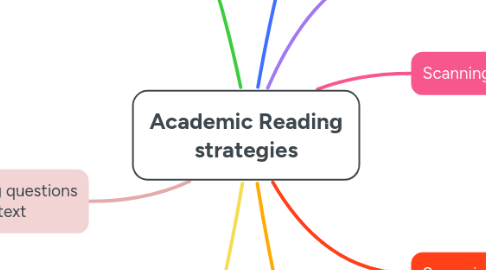
1. Annotating
1.1. It interacts with a text to enhance the readers understanding of, recall of, and reaction to the text
1.1.1. The author's main points, shifts in the message, key areas of focus, and your own thoughts as you read.
1.1.2. strategies to make the most of your efforts
1.1.2.1. Legend on your paper that indicates what each marking is for.
1.1.2.2. Using different colors for different types of reaction.
1.1.2.3. Dedicate different tasks to each margin
2. Making questions to the text
2.1. Questioning in order to find and gather information, clarify, and build comprehension
2.2. Some tips to help you use this comprehension strategy:
2.2.1. 1. Don't ask a question you already know the answer to.
2.2.2. 2. Look for clues in the text and then just make a guess to answer your question.
2.2.3. 3.Stop after every heading or paragraph and ask a question.
3. Summarizing
3.1. One way of using another writer's work in your own
3.2. Summary may be just one or two sentences to explain the main idea of the article.
4. Skimming
4.1. Focus on the parts which are more likely to contain the main ideas, such as:
4.1.1. 1. Title, sub-title, abstract and section headings.
4.1.2. 2. First and last paragraph.
4.1.3. 3. Repeated words.
4.1.4. 4. First and last sentence of each paragraph.
5. Scanning
5.1. Looking for key words or phrases to locate the information more quickly
6. Scanning vs Searching
6.1. The main difference betwen these techniques is to focus on looking for an idea instead of scanning for a word or phrase.
7. Surveying
7.1. Focus on the general aspects of a text to determine if it's worth reading more closely.
7.1.1. 1. Details about the author
7.1.2. 2. Date of publication
7.1.3. 3. Title and sub-title
7.1.4. 4. Abstract, introduction and conclusion.
7.1.5. 5. Section headings and graphics.
8. Note taking
8.1. Before note taking notes you need to identify the main ideas to make your notes clear and concise.
8.1.1. Other useful tips are:
8.1.1.1. 1. Making notes on the source and main points.
8.1.1.2. 2. Try to use your own words.
8.1.1.3. 3. Make clear distinctions between the ideas in the text and your own.
